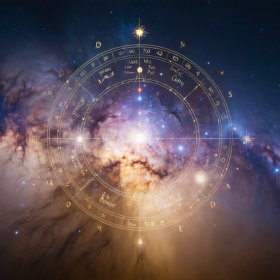Delve into the fascinating connection between zodiac signs and karma. This exploration uncovers how astrological placements might reflect past actions and influence present-day experiences. We’ll examine how each sign embodies specific karmic lessons and opportunities for growth, providing insights into your personal journey and potential for spiritual evolution. Discover how understanding this interplay can empower you to navigate life’s challenges with greater awareness and purpose.
Understanding Karma A Cosmic Perspective
The principle of karma, a cornerstone of Indian philosophical and religious traditions, offers a profound cosmic perspective on existence. Originating in ancient texts and evolving across systems like Hinduism, Buddhism, and Jainism, karma is fundamentally the law of cause and effect applied to conscious beings. Derived from the Sanskrit word *kri*, meaning “to do” or “to act,” it posits that every action – whether physical, mental, or verbal – generates consequences that will inevitably return to the doer. This is not merely a system of divine reward or punishment, but rather an intricate, self-governing mechanism inherent in the fabric of reality, designed for spiritual evolution and learning across countless lifetimes.
Understanding karma requires looking beyond simplistic notions of good deeds leading to good outcomes and bad deeds to bad. While that basic principle holds, the karmic landscape is far more complex. Classical teachings identify different classifications of karma that shape one’s present and future. *Sanchita* karma refers to the vast storehouse of accumulated actions from all past lives, representing the total potential karma yet to manifest. It is like the grain stored in a cosmic granary. From this immense reservoir, a portion is allocated for the current lifetime; this is *prarabdha* karma. *Prarabdha* is the karma that is ripe and currently unfolding, determining the circumstances of one’s birth, innate tendencies, relationships, and major life events – the harvest being reaped now. Finally, *agami* (or *kriyamana*) karma is the karma being created *in* the present moment through the actions, intentions, and thoughts of this life. These present actions add to the *sanchita* store or directly influence future *prarabdha*.
Crucially, karma emphasizes the role of intention (*bhava* or *chetana*) alongside the action itself (*kriya*). A well-intentioned act, even if flawed in execution, carries different karmic weight than a harmful act performed with malice. Thoughts, often seen as the seeds of action, also contribute significantly to one’s karmic account. This highlights karma’s focus on internal state and moral responsibility.
The concept of reincarnation is intrinsically linked to karma. Since the full consequences of actions may not manifest within a single lifespan, the soul undergoes repeated births and deaths, providing the necessary canvas for karma to ripen and for lessons to be learned. Present challenges, talents, and predilections are often seen as the direct result of *prarabdha* karma carried over from previous existences. Life’s difficulties, viewed through a karmic lens, are not random suffering but opportunities to balance past actions and refine character.
Historically, the interpretation and emphasis on karma have varied. Early Vedic texts touch upon ritual action (*karma*) and its results, but the developed philosophical doctrine emphasizing ethical action, intention, and rebirth emerged more prominently in the Upanishads and subsequent philosophical schools. Jainism places strong emphasis on subtle karmic particles clinging to the soul, requiring rigorous asceticism to purify. Buddhism highlights intention and sees karma as fueling the cycle of suffering (*samsara*), which is overcome through understanding emptiness and following the Noble Eightfold Path. Vedanta schools explore the nature of the doer and the possibility of transcending karma through realizing non-duality.
Overcoming “bad” karma is not about avoiding consequences but about *transcending* the karmic cycle itself, or at least mitigating negative outcomes through conscious effort. This involves several paths:
* Understanding the principle of karma (*jnana* or wisdom).
* Living ethically (*dharma*), cultivating positive actions and intentions.
* Practicing mindfulness and self-awareness to control thoughts and reactions.
* Performing actions without attachment to their results (*karma yoga*), thereby not creating new binding karma.
* Accepting *prarabdha* karma with equanimity and learning from it.
* Engaging in spiritual practices that purify the mind and transcend ego, which is seen as the source of the sense of doership and therefore karmic accumulation.
Ultimately, the aim is to burn up existing karma and cease creating new karma that binds the soul to the cycle of rebirth, leading to liberation (*moksha* or *nirvana*). While this spiritual goal represents the culmination of the karmic journey, the principles of cause and effect and conscious evolution are understood to profoundly influence the individual soul’s trajectory, leaving imprints that are unique to its journey and express themselves in various ways in each lifetime.
Zodiac Signs Karmic Imprints and Life Lessons
The individual astrological chart serves as a unique cosmic blueprint, not merely describing personality traits but also hinting at the deep karmic currents that shape our existence, as discussed in the previous chapter regarding the principle of cause and effect. Each of the twelve zodiac signs embodies specific energetic patterns, representing lessons the soul has experienced or needs to master across lifetimes. Examining these signs through a karmic lens reveals potential past-life baggage, inherent strengths, and the precise lessons destiny asks us to embrace in this incarnation.
Let’s delve into the karmic imprints carried by each sign:
* Aries: Often carries the karmic pattern of initiation and independent action. Past lives might have involved roles requiring decisive leadership or solitary survival, leading to present-day strengths in courage and pioneering spirit. The karmic lesson involves balancing self-assertion with consideration for others, moving from impulsive will to conscious initiative. Their challenge lies in learning patience and cooperation, potentially dealing with karmic debts related to past aggression or selfishness. The nodal axis for Aries/Libra highlights the journey from focusing solely on self (Aries) to integrating partnership and balance (Libra).
* Taurus: Karmic roots often lie in accumulating resources or seeking stability. Past lives might have involved themes of deprivation or material control, manifesting as a present focus on security, comfort, and sensuality. The karmic lesson is about discerning true value beyond the material, learning to share, and cultivating inner security rather than relying solely on external possessions. Debt might involve attachment; blessings, a natural connection to abundance. Their nodal axis (Taurus/Scorpio) points to moving from fixed material focus to embracing transformation and shared power.
* Gemini: This sign frequently carries karmic imprints related to communication and duality. Past lives might have involved roles as messengers, scholars, or even tricksters, leading to present curiosity and adaptability. The karmic lesson is about integrating disparate ideas, finding truth in communication, and moving beyond superficial knowledge to genuine understanding and authenticity of expression. Challenges involve scattered energy or dishonesty. The Gemini/Sagittarius axis emphasizes the shift from gathering diverse information (Gemini) to seeking higher truth and wisdom (Sagittarius).
* Cancer: Often holds karmic patterns related to nurturing, family, and emotional security. Past lives might have involved intense family ties, loss of home, or roles as caregivers, resulting in present strengths in empathy and protection. The karmic lesson involves establishing emotional independence while still fostering connection, releasing codependency, and learning to nurture oneself. Karmic debts might involve emotional manipulation; blessings, deep intuitive connection. The Cancer/Capricorn axis signifies the journey from relying solely on emotional comfort zones (Cancer) to building responsible external structures and authority (Capricorn).
* Leo: This sign carries karmic echoes of leadership, creativity, and self-expression. Past lives might have involved positions of power, performance, or the need to assert identity, leading to present confidence and a desire to shine. The karmic lesson centers on selfless service through creative expression, distinguishing true authority from ego-driven control, and learning humility. Challenges involve pride or seeking external validation. The Leo/Aquarius axis suggests moving from personal recognition and creative flair (Leo) towards contributing unique gifts for the collective good (Aquarius).
* Virgo: Often embodies karmic imprints of service, analysis, and perfectionism. Past lives might have involved roles as healers, analysts, or servants, leading to present strengths in practicality and attention to detail. The karmic lesson is about embracing imperfection, trusting intuition alongside logic, and serving others without losing oneself in martyrdom or excessive criticism. Debts might involve judgment; blessings, meticulous skill. The Virgo/Pisces axis indicates the path from focusing on tangible details and service (Virgo) to embracing faith, compassion, and universal interconnectedness (Pisces).
* Libra: This sign frequently carries karmic patterns related to relationships, justice, and balance. Past lives might have involved negotiating conflicts, seeking harmony, or facing injustice, resulting in present diplomacy and a desire for fairness. The karmic lesson involves developing inner conviction independent of others’ opinions, learning assertive decision-making, and finding true balance within, not just externally. Challenges involve indecision or people-pleasing. The Libra/Aries axis underscores the journey from prioritizing partnership and external harmony (Libra) back to establishing a strong sense of individual identity (Aries).
* Scorpio: Often holds karmic roots in transformation, power dynamics, and intense emotional experiences. Past lives might have involved themes of death, power struggles, or hidden truths, leading to present resilience and depth. The karmic lesson involves authentic emotional expression, surrendering the need for control, and using personal power for healing rather than manipulation. Debts might involve betrayal or control issues; blessings, profound regenerative capacity. The Scorpio/Taurus axis highlights the movement from fixed material accumulation (Taurus) towards emotional depth, transformation, and shared resources (Scorpio).
* Sagittarius: Carries karmic imprints of seeking truth, freedom, and expansion. Past lives might have involved roles as philosophers, travelers, or teachers, resulting in present optimism and a love for exploration. The karmic lesson is about integrating higher knowledge with practical application, learning responsibility alongside freedom, and finding wisdom beyond dogma. Challenges involve restlessness or intolerance. The Sagittarius/Gemini axis signifies the journey from acquiring scattered knowledge (Gemini) to synthesizing it into a personal philosophy and quest for meaning (Sagittarius).
* Capricorn: Often embodies karmic patterns related to responsibility, structure, and authority. Past lives might have involved building empires, dealing with hardship, or holding positions of power, leading to present discipline and ambition. The karmic lesson involves learning compassionate leadership, achieving goals with integrity, and balancing material success with emotional fulfillment. Debts might involve rigidity or abuse of power; blessings, innate leadership ability. The Capricorn/Cancer axis suggests the path from focusing on external achievement and control (Capricorn) to embracing emotional vulnerability and nurturing family bonds (Cancer).
* Aquarius: This sign frequently holds karmic roots in innovation, community, and detachment. Past lives might have involved breaking norms, participating in groups, or experiencing alienation, resulting in present originality and humanitarian ideals. The karmic lesson is about balancing revolutionary ideas with practical implementation, engaging with community without losing individuality, and cultivating emotional intelligence alongside intellectual pursuits. Challenges involve aloofness or stubborn idealism. The Aquarius/Leo axis points to moving from seeking personal recognition and creative flair (Leo) towards contributing unique visions for the collective good (Aquarius).
* Pisces: Often carries karmic imprints of compassion, surrender, and dissolution of boundaries. Past lives might have involved roles as mystics, victims, or healers, leading to present empathy and artistic sensitivity. The karmic lesson is about discerning reality from illusion, establishing healthy boundaries, channeling compassion effectively, and integrating spirituality with earthly life. Debts might involve escapism or deception; blessings, profound intuition and artistic talent. The Pisces/Virgo axis indicates the journey from focusing on tangible details and service (Virgo) to embracing faith, compassion, and universal interconnectedness (Pisces), integrating the mundane with the divine.
Notable astrologers like Stephen Arroyo and Jeffrey Wolf Green have extensively explored how the birth chart, particularly the nodal axis placements, serves as a map of the soul’s evolutionary journey, highlighting the karmic patterns carried forward and the direction for spiritual growth in this lifetime. They emphasize that the South Node represents ingrained habits and past-life comfort zones, while the North Node points towards the essential karmic lessons and development required for soul evolution. Understanding your sun sign’s general karmic imprint, combined with the specific placement of your nodal axis, provides powerful insights into the specific karmic lessons you are destined to master, guiding your path towards integrating past experiences and embracing your future potential.
Integrating Astrology and Karma for Personal Growth
Integrating the insights gleaned from understanding the karmic imprints associated with the zodiac signs provides a powerful framework for embarking on a journey of personal growth and heightened self-awareness. While the previous discussion detailed the specific lessons and past-life influences embedded within each sign’s nature, this knowledge serves as a cosmic mirror, reflecting not a fixed fate, but the energetic blueprints we inherit and the patterns we tend to repeat. Recognizing these karmic tendencies, illuminated by the unique configuration of our birth chart – beyond just the Sun sign – allows us to move beyond reactive behaviors driven by unconscious patterns and step into a more conscious, proactive engagement with our lives.
Practical application begins with using the astrological chart as a tool for self-reflection. The challenges indicated by certain planetary placements, aspects, or house positions often pinpoint specific areas where karmic lessons are most acute or where repetitive patterns manifest. For instance, a challenging aspect involving Saturn might highlight areas of limitation, fear, or responsibility that are karmically significant, representing lessons in mastery or discipline carried forward. Conversely, a strong Jupiter placement could suggest areas of inherent grace or opportunity, perhaps reflecting positive karma accumulated in past lives. By studying these specific placements, individuals can identify the *themes* and *arenas* of their primary karmic work, moving beyond a general understanding of their sign’s lessons to a more personalized view of their soul’s curriculum. This understanding isn’t about blame or predestination; it’s about pinpointing the roots of struggles or inherent talents to approach them with greater awareness and intention.
Crucially, understanding karma through astrology does not negate the power of free will. While the birth chart reveals the karmic “hand” we’ve been dealt – the inherited patterns, predispositions, and lesson areas – it is our conscious choices and responses in the present moment that actively shape our ongoing karmic destiny. Astrology shows the *tendencies* and the *terrain*; free will is the compass and the ability to choose the path. We are not passive recipients of fate, but active participants in its unfolding.
This is where conscious practice becomes essential for mitigating negative karma and cultivating positive influences. Practices such as meditation and mindfulness are invaluable tools. They cultivate awareness of our thoughts, intentions, and actions *before* they fully solidify into karmic consequences. By observing the mind without judgment, we can identify ingrained reactive patterns (often karmically rooted) and consciously choose a different response. Ethical conduct – acting with compassion, integrity, generosity, and non-violence – is the fundamental engine for creating positive karma. These actions generate ripples of beneficial energy, counteracting past negative imprints and building a foundation for future well-being and harmony. Engaging in selfless service is another powerful way to dissolve ego-driven karmic ties and generate positive merit.
Aligning with one’s dharma is perhaps the most profound way to integrate astrological and karmic understanding for fulfillment. Dharma can be seen as one’s soul purpose, inherent nature, or righteous path in life. The birth chart can offer clues to this path, often indicated by the North Node’s trajectory, the Midheaven’s sign and planetary rulers (representing career/public path), and the strengths and talents highlighted by well-placed planets. When individuals live in accordance with their dharma – contributing their unique gifts to the world and acting in alignment with their deepest truth – they create positive karma naturally. It is an expression of being in flow with the universal design, leading to a sense of deep satisfaction and karmic harmony. Actively shaping your karmic destiny involves consistently choosing awareness over unconscious reaction, ethical action over harmful behavior, and alignment with your authentic purpose over societal expectation, using the astrological blueprint as a guide for where this inner work is most needed and potentially most fruitful.
Conclusions
In conclusion, exploring the intersection of zodiac signs and karma provides a powerful lens for understanding ourselves and our life’s journey. By recognizing the potential karmic imprints associated with our astrological placements, we gain insight into the lessons we’re meant to learn. Embracing this awareness empowers us to make conscious choices, break negative patterns, and actively shape a more fulfilling and karmically balanced existence. Ultimately, the stars illuminate a path towards personal growth and spiritual evolution.


